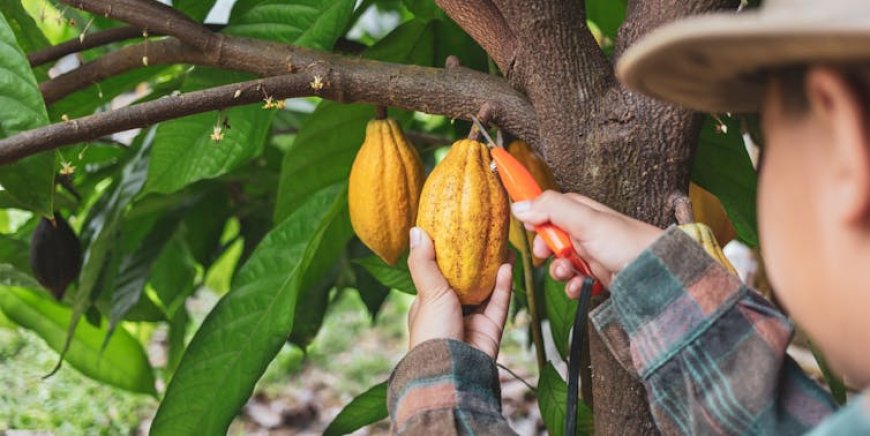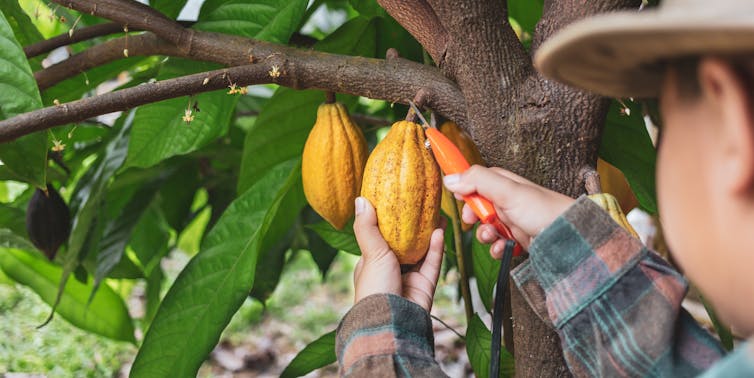How blockchain technology could help to prevent child labour in global supply chains

Child Labour in Supply Chains: A Call for Transparency and Accountability
How would you feel if the phone in your pocket or the chocolate treat you just enjoyed was made using child labour? The idea might appal you, but the truth is that child labour is lurking behind the manufacture of familiar everyday products including electronic devices and food.
It is particularly prevalent in industries such as cobalt mining and cocoa production. And as a recent BBC investigation revealed, it can also be found in the supply chains of well-known cosmetics brands.
Despite big companies attempting to implement zero-tolerance policies, they may be unaware that child labour is a feature of their complex manufacturing processes. But research suggests it is widespread in international supply chains. UN figures from 2021 suggest the number of child labourers in the world is around 160 million.
The Role of Sustainable Development Goals (SDGs)
- Goal 8: Decent Work and Economic Growth
- Goal 12: Responsible Consumption and Production
- Goal 16: Peace, Justice, and Strong Institutions
So what can be done? Various attempts have been made to address the issue, including audits, due diligence policies, and efforts to secure responsible sourcing, albeit with varying degrees of success.
The Potential of Blockchain Technology
One potential solution could be found in blockchain technology.
Blockchains are a kind of digital database most often used in cryptocurrency transactions. The technology is essentially a way of storing and sharing information along global supply chains – like a virtual ledger which ensures that data is secure and transparent.
But it could also be used to make sure that products are made ethically and without child labour by keeping track of transactions.
This is how it could work:
- Whenever a product is harvested or mined, it is immediately assigned a digital ID and its details are recorded, like a digital birth certificate. This is the first part of the chain.
- Then, each time the product is transported or processed, a new “block” of information is added to its ID. Each additional block gradually forms the blockchain – a clear trail of where the product has been and what has been done to it.
If big companies had access to all of this information, supply chain transparency would be vastly improved. And because the technology records a product’s journey from start to finish, it would be hard to hide any unethical practices – such as child labour.
It would also include contracts written in programming codes (known as “smart contracts”) which help to verify whether or not labour standards have been met – triggering audits or recording ethical practices.

Narong Khueankaew/Shutterstock
If there’s a dispute along the supply chain between buyers and sellers, the blockchain provides a digital logbook that settles arguments. Workers can also use secure digital IDs to ensure that only people who are legally allowed to work are employed, preventing child labour.
Another advantage would be the secure recording of all payments, meaning workers get the pay they are promised, and companies who don’t pay fairly can be held accountable.
Challenges and Considerations
But my research suggests that implementing blockchain technology would not be an easy fix. For while it could help improve tracking and accountability, large companies may be able to adopt it in ways that benefit their operations and reputation. They can set the rules and standards and decide who gets access to the data it generates.
Closed blockchain systems would make it hard for smaller suppliers to benefit from the technology, potentially resulting in giving more power to large firms instead of improving working conditions.
Read more: ‘We miners die a lot.’ Appalling conditions and poverty wages: the lives of cobalt miners in the DRC
Also, in developing economies, many small-scale farmers and suppliers do not have the technological infrastructure – like smartphones or reliable internet connections – required for blockchain technology to be implemented. Recent research suggests that one possible solution to this would allow transactions to be recorded by text messages.
In this way, transactions between farmers and buyers could be documented using basic mobile phones. Information about the farmer’s ID and the amount of cocoa being sold, for example, would then be securely recorded in a blockchain (perhaps via an app or web page), ensuring transparency.
Such a system would allow farmers with limited access to technology to participate in secure and trustworthy transactions – and to engage in fairer and more accountable supply chains that reduce the amount of child labour across the world.
SDGs, Targets, and Indicators
-
SDG 8: Decent Work and Economic Growth
- Target 8.7: Take immediate and effective measures to eradicate forced labor, end modern slavery and human trafficking, and secure the prohibition and elimination of the worst forms of child labor.
- Indicator 8.7.1: Proportion and number of children aged 5-17 years engaged in child labor, by sex and age group.
-
SDG 12: Responsible Consumption and Production
- Target 12.2: By 2030, achieve the sustainable management and efficient use of natural resources.
- Indicator 12.2.1: Material footprint, material footprint per capita, and material footprint per GDP.
-
SDG 16: Peace, Justice, and Strong Institutions
- Target 16.5: Substantially reduce corruption and bribery in all their forms.
- Indicator 16.5.1: Proportion of persons who had at least one contact with a public official and who paid a bribe to a public official, or were asked for a bribe by those public officials, during the previous 12 months.
Analysis
The article addresses the issue of child labor in various industries, including cobalt mining, cocoa production, and cosmetics manufacturing. Based on this, the following SDGs, targets, and indicators can be identified:
SDG 8: Decent Work and Economic Growth
The article highlights the prevalence of child labor in different industries, which is directly connected to Target 8.7 of SDG 8. This target aims to eradicate forced labor, end modern slavery and human trafficking, and eliminate the worst forms of child labor. The article mentions that child labor is widespread in international supply chains, indicating the need for immediate and effective measures to address this issue.
The indicator relevant to this target is Indicator 8.7.1, which measures the proportion and number of children aged 5-17 years engaged in child labor, by sex and age group. The article cites UN figures from 2021, which suggest that the number of child laborers in the world is around 160 million.
SDG 12: Responsible Consumption and Production
The article emphasizes the importance of responsible consumption and production to address the issue of child labor. It suggests that blockchain technology can be used to ensure products are made ethically and without child labor by improving supply chain transparency. This aligns with Target 12.2 of SDG 12, which aims to achieve the sustainable management and efficient use of natural resources.
The indicator relevant to this target is Indicator 12.2.1, which measures the material footprint, material footprint per capita, and material footprint per GDP. While the article does not directly mention this indicator, it indirectly relates to the responsible management of resources in supply chains to prevent child labor.
SDG 16: Peace, Justice, and Strong Institutions
The article briefly mentions the potential advantage of blockchain technology in settling disputes along the supply chain between buyers and sellers. This relates to Target 16.5 of SDG 16, which aims to substantially reduce corruption and bribery in all their forms.
The indicator relevant to this target is Indicator 16.5.1, which measures the proportion of persons who had at least one contact with a public official and who paid or were asked for a bribe. While the article does not explicitly mention this indicator, it highlights the potential for blockchain technology to improve transparency and accountability, reducing unethical practices such as child labor.
Table: SDGs, Targets, and Indicators
| SDGs | Targets | Indicators |
|---|---|---|
| SDG 8: Decent Work and Economic Growth | Target 8.7: Take immediate and effective measures to eradicate forced labor, end modern slavery and human trafficking, and secure the prohibition and elimination of the worst forms of child labor. | Indicator 8.7.1: Proportion and number of children aged 5-17 years engaged in child labor, by sex and age group. |
| SDG 12: Responsible Consumption and Production | Target 12.2: By 2030, achieve the sustainable management and efficient use of natural resources. | Indicator 12.2.1: Material footprint, material footprint per capita, and material footprint per GDP. |
| SDG 16: Peace, Justice, and Strong Institutions | Target 16.5: Substantially reduce corruption and bribery in all their forms. | Indicator 16.5.1: Proportion of persons who had at least one contact with a public official and who paid a bribe to a public official, or were asked for a bribe by those public officials, during the previous 12 months. |
Source: theconversation.com








